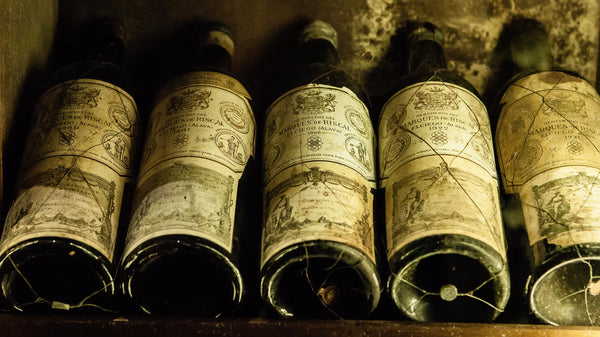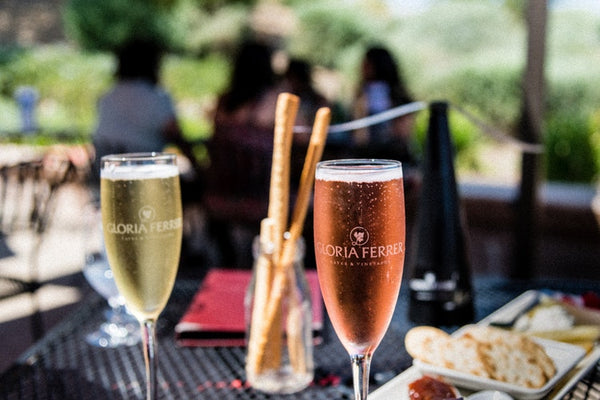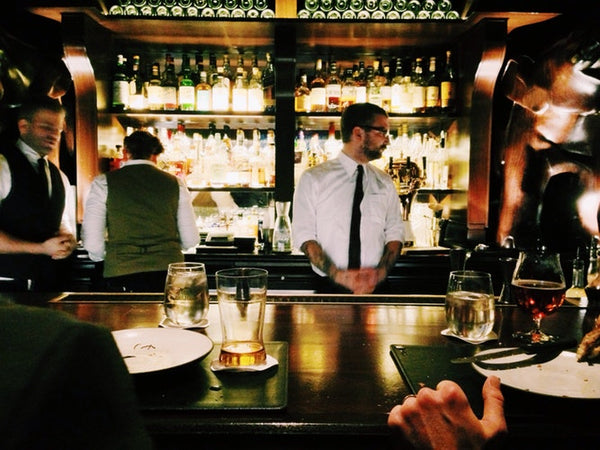
Your Guide to Ordering Wine in a Restaurant
One of the most intimidating things that people find about wine, is trying to order a bottle in a restaurant and it's not hard to see why! Being presented with a potentially weighty wine list full of obscure names and quickly spiralling prices, the ritual of the tasting portion, the concern about the food and wine pairings, not to mention never knowing if you can actually send the bottle back or not! With that in mind, we've put together a short guide to give you some hints and tips, to hopefully change that feeling of dread into something quite wonderful instead.
So, imagine the typical restaurant scene you find yourself in. It could be a date, a work dinner, or an evening with friends. As someone who's 'into' wine, it's inevitable that the wine list ends up in your hands, whether you're familiar with the wines that the restaurant is serving or not! There's nothing worse than being expected to pick out a delicious Aglianico from Campania in southern Italy, when your expertise lies in the wines of California. Now, before we get into the individual elements and ways of looking at it, we'd like to state a few things that we believe to be true, in any scenario:

Ask For Advice
Truthfully, this is the area where everyone feels uncomfortable, for some reason, as though asking for advice from a waiter or sommelier somehow diminishes your own wine knowledge. It's simply not possible to know everything about wine, and in a good restaurant the wines will have been chosen for specific reasons, whether it be style, geographical location or that they work particularly well with the food. Interestingly, in our experience it's been the more knowledgeable people who are most comfortable asking for suggestions in bars and restaurants, so never fear on that front! The sommelier or manager should know the wine list inside and out, so make the most of their expertise.
Stick to Your Budget
If you went out with a strict budget, don't let yourself be talked out of it. Fine wine is rarely an affordable choice at the best of times, but with the often large mark-ups in restaurants and the self-imposed pressure to choose the 'right' bottle, it can get out of hand quite quickly. If you're following our advice above, it's the most valuable piece of information you can give to the person helping you, and they should then be sure to stay within that budget.
No Wine? No Problem!
This might sound like odd advice in a guide that's focused on getting the most out of the wine list in restaurants, but really, sometimes it just does make sense! Whether it's because you're in a restaurant with an uninspiring and/or excessively expensive wine list, because it doesn't match your dish or just because you'd prefer a beer or a soft drink; don't feel compelled to choose wine! There have been more than a few occasions where a wine was shoe-horned into a meal where truthfully, water would have sufficed just as well. If you still fancy a drink, there's always the after-dinner cocktail to consider instead.
So, with all that being said, let's have a look at some of the choices you have when choosing a bottle of wine in a restaurant, how to get the most out of it and some general hints and tips! Bear in mind that this will vary slightly according to wine knowledge; when you spot a producer you love at a good price, other considerations tend to go out of the window!

Food and Wine Pairings
Food and wine pairings are often the most important consideration when choosing a bottle of wine in a restaurant, and a great example of how wine doesn't exist in a vacuum. There's two ways to go about it, of course: choosing a great bottle of wine and ordering to match, or the more common way of choosing what you'd like to eat, then searching for the right bottle of wine to go with it. As the latter is by far the most common, there are a few simple rules you can follow that really help in creating the right combination; an experience greater than the sum of its parts. The most important element of all is matching the body of the food and the wine, that is the weight and style of both. For example, if you're eating rich, red meat then you'll want something equally weighty and powerful to go with it; Cabernet Sauvignon, Zinfandel, Grenache et all do well here. If you were to order delicate, white fish then the same choices would be far too much, whereas a crisp Albarino, a delicate Muscadet or steely Chablis would be ideal.
You can go into food and wine pairing in far more detail and fortunately, we've written a separate guide all about it, in 7 easy steps! Read on for more food and wine pairing ideas:

Older Vintages
One of the great joys of drinking wine at a good restaurant is the opportunity to try older vintages. Particularly if a restaurant is famous for a certain style of wine, be in Bordeaux, Champagne or Napa Valley, they're likely to have some interesting older wines on the list, often that don't cost substantially more than the more current releases. Wine prices have increased quite drastically in the last 10-15 years, particularly amongst the more famous producers of the world. As a result, it's often quite possible to try a 1996 Bordeaux for much the same price as a 2010! If you're in the mood for something a little more adventurous, find a producer you love and see how far back the wines go; you might be in for a pleasant surprise!

Sparkling Wines for Dinner
Sparkling wines don't always get the love they deserve, perhaps with some notable exceptions in Champagne. However, something we've discovered over the years is just how food-friendly sparkling wines can be; often with a touch of residual sugar, high levels of acidity and a mousse that helps them stand up to heartier dishes. Better yet, they're light, refreshing and outside of the more famous cuvees, rarely break the bank! It might sound odd ordering a sparkling wine for the entire dinner, but give it a try and you won't be disappointed. If in doubt, look for a producer making bolder, richer styles; Louis Roederer in Champagne and Anderson Valley is a personal favourite for us on this front!

The Tasting Ritual
Ah, the tasting ritual, that endless source of confusion! You know what we're referring to; you've ordered your bottle of wine and it's been opened with some ceremony, and a small splash is served to who-ever ordered it. Why do they do this? What's the point of it? Who-ever is tasting it suddenly feels very on the spot, and there's rarely a response other than 'mmmm, lovely'.
In truth, this is simply a slightly outdated service habit. The idea is that, if there are any faults or problems with the wine (which we'll come onto in a moment), you can detect them and send the wine back to be exchanged with a bottle that doesn't have a problem. The issue? The majority of people, including many in the trade, aren't experienced at detecting problems and issues with wine. Ideally the sommelier should have a small tasting sip to ensure the wine is drinking as it should, before pouring for the table. So, the next time this happens, enjoy your small taste and should you detect any problems with the wine, do bring it up and ask for it to be checked.

Sending Wine Back
On this note, another concern in restaurants is when you can send a bottle back. The tasting ritual above is the ideal time, but some quick words on when to send a bottle back:
- In a wine has any obvious faults or flaws, you can happily send it back to be replaced with another bottle or, perhaps with a different choice entirely. Faults and flaws are issues with the wine beyond the norm of not enjoying the taste. We've written a guide to detecting them here; give it a read!
- If it's a wine you know well and it isn't tasting at all how it should. There are many things that can change in a bottle of wine according to temperature, storage conditions, travel and so on, so don't be afraid to say 'This bottle isn't how it should be'
- If there is something really unpleasant about the wine, but you're struggling to put your finger on it. In this case, the waiter/sommelier will probably retaste it, but it's your prerogative as a customer to choose the wine or not.
- If the wine has come recommended by the restaurant but you don't enjoy it at all. Part of the job of a sommelier is to find you the right bottle for your budget, style and so on, so if it's their proposed wine and you don't enjoy it, don't feel obliged to take it.
This sounds easy enough, but we know it can be embarassing to get into a discussion with the restaurant about whether they'll take a bottle back or not. There are even occasions when you'll mistakenly try and send a wine back and there's nothing wrong with it in truth; it happens all the time. A good restaurant doesn't spend time arguing with customers about these sorts of issues and in the majority of cases, they'll be able to recoup any lost money by selling that wine by the glass. If there is something wrong with the wine, they'll be able to get a replacement bottle from their distributor, so no loss either way. Naturally, don't send the wine back if there truly isn't anything wrong with it and you've simply made the wrong choice.

Corkage
Finally, corkage is something to consider if the restaurant allows it. Corkage is simply a fee you pay to bring your own wine into the restaurant, and normally covers the lost margin that a restaurant would make if they sold you a bottle of wine. Always make sure to call and ask ahead of time, as many restaurants don't allow corkage and won't respond kindly to you showing up with a bottle of wine, ready to open.
Restaurants that do allow corkage will normally have their own rules around it, beyond the cost, such as a maximum number of bottles per person. The general idea is not to take advantage of a restaurants hospitality by turning a small dinner into a giant wine tasting at a lower cost. Ideally, also share a little of the wine you've brought with the sommelier/wait staff so they can get a taste and improve their palate. Another common courtesy with larger tables, is to bring a few bottles of wine but also get a bottle or two from the main list. There's no fast-rules for corkage, just be sure that you're treating it as a special priviledge rather than a right; fewer and fewer restaurants allow for it, so be sure to make life easy on those that do!
With that concludes our guide to ordering wine in a restaurant; we hope you've found it useful! In an ideal world, it should be a pleasurable part of the dining experience rather than a cause for concern, and much of this will depend on the waiting staff and the sommelier team, if there is one. We mentioned this at the beginning but for emphasis; don't ever worry about asking for help if you need it! That's what sommeliers are hired to do and they'll know their list better than anybody. Cheers!
For more on our specially designed wine luggage and more detailed information on how to travel with alcohol, check out the links below:









Deixar comentário
Este site é protegido por hCaptcha e a Política de privacidade e os Termos de serviço do hCaptcha se aplicam.